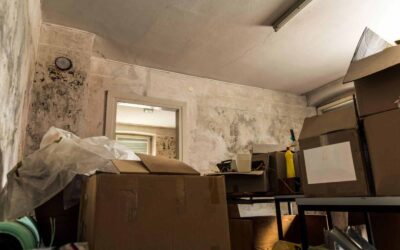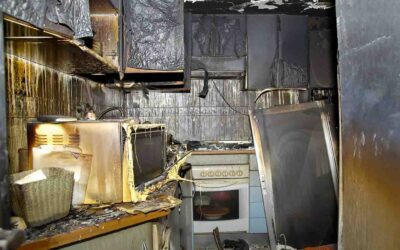If you’re reading this blog post in the United States, there’s nearly a 50 percent chance you’re sharing your home with a dangerous uninvited guest: mold. Capable of causing or exacerbating a number of different health conditions, including asthma, bronchitis, allergies, migraines, and chronic inflammatory response syndrome (CIRS). The mycotoxins produced by mold have even been linked with neurological conditions such as Alzheimer’s. The structure of your home is at risk too. Mold can rot the wooden infrastructure of your home, reducing its value and necessitating costly repairs.
Mold and other fungi can rapidly reproduce and grow out of control. All they require is a little moisture to take hold. As a result, it’s extremely difficult to remove because even thoroughly scrubbing an area won’t do the trick if there are spores remaining to restart the growth process. The task of removing it completely—referred to as remediation—is a challenging prospect because mold and other fungi are extremely hardy. That’s why the best way to ensure the job gets done is through a process known as bio-remediation. This process is excellent for removing not only mold spores but other contaminants as well.
Biodynamic has pioneered this process, which is why we’re able to achieve results that other restoration companies cannot. In the following article, we’ll discuss how bio-remediation works, why it’s so effective, and why it’s safer and more ecologically friendly than other methods.
Signs Your Home May Be Contaminated
A building contaminated by mold may or may not have obvious signs. Often, you can identify its presence when large brown or black stains appear. These spread along water-damaged areas caused by leaky roofs or other sources of moisture. In some cases, you may notice a musty odor, which could indicate the presence of mold growth as well.
Sometimes, mold isn’t as easy to detect, however. Frequently, it’s an invisible lurker, signaled only by the many problems it creates. If you notice increased incidences of allergy symptoms, such as headaches, coughing, sneezing, itchy, watery eyes, or an unexplained rash, that could be a sign your building is contaminated. Other contaminants, including biological ones that cause allergies and sickness, can also grow in your home while remaining hidden from view.
Bio-Remediation: How It Works
Remediating a mold problem requires thoroughly cleaning all traces of fungal growth in the home. This presents a particular challenge because mold is particularly good at taking hold in every possible nook and cranny. It thrives in damp spaces, including behind walls, under floorboards, under sinks, in basements, and so on. Mold can feed off any organic material that has been affected by moisture.
If any traces are left behind, or if the conditions that produced the mold in the first place—such as a leaky roof—are left in place, then the spores can spread, and the mold can quickly return to a full-blown infestation. This can occur within a matter of days, meaning that it’s crucial to clean all traces of the mold before a recurrence can take place.
Other contaminants, such as bacteria or other pollutants, can be equally difficult to control. They must be thoroughly eliminated to remove the health risks they pose to a home and its residents. Bio-remediation goes beyond simple cleaning. This innovative process involves seven phases designed to eliminate mold and other contaminants while minimizing the chances of them returning.
Bio-remediation is so-called because it uses biological organisms—microbes—to consume and destroy mold spores and related pollutants. Traditional cleaning is also part of the process, with extensive remediation being included as a part of any restoration project.
How It Works
- Phase one is planning. If you suspect mold or other contamination, contact Biodynamic. We work with you to narrow down the source of the problem. We quarantine the area where the growth has taken hold to minimize the spread of the spores and to keep the remediation process contained to necessary areas of the house.
- Contaminated items that can’t be remediated in place are removed from the building to be treated separately. We prioritize preserving items as best we can. Often, even items that are highly saturated with mold or bacteria can still be recovered. In some severe cases, however, this may not be the case. Biodynamic will work with you to create a detailed inventory of all items removed from the home.
- Phase three involves removing all sources of mold. We’ll create containment chambers to effectively isolate areas to be treated during the bio-remediation process. It’s critical at this time to minimize airflow between contained areas.
- In phase four, we place material containing a microbial compound around the contaminated areas. The microbes break down mold spores, toxins, bacteria, and other dangerous compounds and convert them into harmless byproducts.
Other cleaning methods, including vacuuming with a HEPA filter, can then be used. The ultimate goal is to remove any trace of infestation from the home down to the microscopic level.
- Next, any necessary rebuilding is completed. Biodynamic can connect you with our trusted contacts to ensure this work is done properly.
- Phase six includes moving all your belongings back into your home. If you prefer, you can take this task on yourself. Biodynamic can also work with you.
- Phase seven is ongoing maintenance. This includes weekly, bi-weekly, monthly, or quarterly applications of a lighter version of bio-remediation.
What Are the Benefits?
As we’ve mentioned above, bio-remediation is not only one of the most thorough methods for removing microbial contamination; it’s also one of the safest and most ecologically friendly. This is because it doesn’t require the use of harsh or toxic cleaning products—which can damage property and be as harmful to the health of the residents as contaminants. Instead, we rely entirely on harmless natural processes. It also doesn’t produce dangerous byproducts: all traces of the original contamination are harmlessly broken down by the microbial cleaning process.
The other major benefit of bio-remediation is its ability to be utilized repeatedly. While the original cleaning process removes all traces of contamination, areas that are frequently exposed to further contaminants can be retreated as needed.
To set up bio-remediation for your home, contact Biodynamic today. Our experts will work with you to ensure your home is clean and healthy for many years to come.


